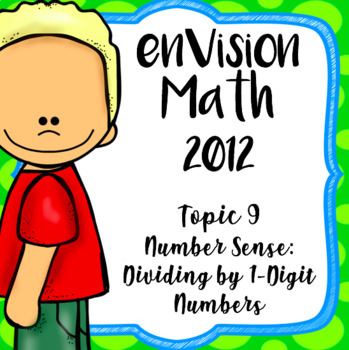EnVision Math 2012 Grade 4 Topic 9 Dividing by 1-Digit Numbers, Daily Powerpoint
- PPTX
What educators are saying
Also included in
- Save with the BUNDLE! Let me save you hours and hours of planning! This powerpoint contains guided PowerPoints for topics 9, 10, 11, and 12 from the 2012 CCSS EnVision Math series. (Version 2.0 is in the works!)Topic 9 - Number Sense, Dividing by 1-Digit DivisorsTopic 10 - Developing Fluency, DividPrice $8.00Original Price $10.00Save $2.00
- Daily guided lessons for topics 1-16 of the 2012 Common Core version! If you need a different copyright, use these links for the full library of the 2012 version, the Common Core 2.0 (2016 version), or the newest Common Core 2020 version.This took me a year to create and perfect with my own studentPrice $37.00Original Price $47.00Save $10.00
- Save with the BUNDLE! Daily guided lessons for half the year! Let me save you hours and hours of planning! This powerpoint contains 1,589 slides for topics 9-16 of the CCSS EnVision Math series, 2012. These lessons follow the same sequence as the student textbook, so it'll seamlessly fit into yourPrice $21.60Original Price $24.00Save $2.40
Description
Daily Lessons, done for YOU! EnVision 2012 (Version 2.0 is in the works!) Let me save you hours of planning! This powerpoint contains 132 slides for topic 9.
If you need a different copyright, use these links for the full library of the 2012 version, the Common Core 2.0 (2016 version), or the newest Common Core 2020 version.
Leave the teacher's manual behind and guide students through topic 9 with these colorful and detailed slides. These slides will walk you and your students through every lesson in topic 9 beginning with the lesson's purpose (I have students volunteer to read this each day), any new vocabulary, and skill teaching/guided student practice and opportunities for students to apply what they've learned!
Slides give guidance for you, their teacher, too! I have small notes letting you know if you should "go on" to next slide and also give you a heads up if the next slide contains the answer, so you don't show it before students have an opportunity to solve it themselves. I use these notes for myself as well, because I can never remember what slide comes next. This makes them foolproof!
They are fully editable so you can add/change anything that you need to meet the needs of your classroom. I like to add a slide at the end of the lesson with "next steps" that may include their independent classwork assignment, their homework assignment, reminders about tests, or anything else you want to post to guide through the last part of the math period.
Lessons Included in this topic are:
9-1 Using Mental Math to Divide
9-2 Estimating Quotients
9-3 Estimating Quotients of Greater Dividends
9-4 Dividing with Remainders
9-5 Multiplication and Division Stories
9-6 Problem Solving








